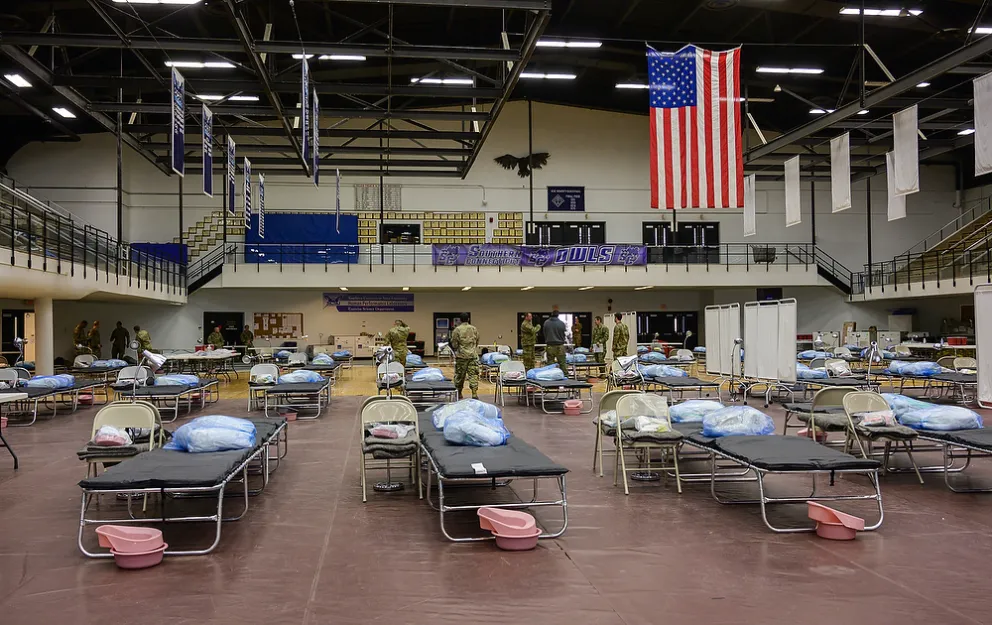
(photo by Isabel Chenoweth) A gymnasium at Southern Connecticut State University in New Haven, CT is transformed into an emergency medical facility in response to the Coronavirus outbreak.
The motto of UPAA is "The Visual History of Higher Education."
The COVID-19, or Coronavirus, pandemic is almost without debate the most significant crisis to impact higher education in the history of our organization. In other times of tragedy or disaster, an event may occur in a particular region or city. A few are impacted and most watch, reflect in our own ways, and send help through donations or active volunteer efforts. Daily life is largely unaffected. The current pandemic, however, has impacted every UPAA member and member institution in at least some way. In only days, sports seasons and major events were cancelled, and campuses emptied. The upheaval was felt across the nation. Private, public...large, small...everyone changed seemingly overnight.
The UPAA motto has never been more relevant.
“Now more than ever the recording of visual history is essential," said Glenn Carpenter, UPAA president and photographer at Moraine Valley Community College in Palos Hills, IL. "We are witnessing events that will be a bookmark in the lives of faculty, staff, students and our schools. The need to remember these times may not be fully realized as we are living them, but those that follow us will need to know what was done, the impact, how to do it better, and to remember this unprecedented time in history. Your images are so much more than marketing and promotion, they are the Visual History of Higher Education.”
Our members have continued to document and communicate during this unprecedented time. In this article, several UPAA members share their work and their thoughts on the first few weeks of this new situation.
SUSAN McSPADDEN - Johnson County Community College - Overland Park, KS
"I am fortunate to have great support from all corners of campus."
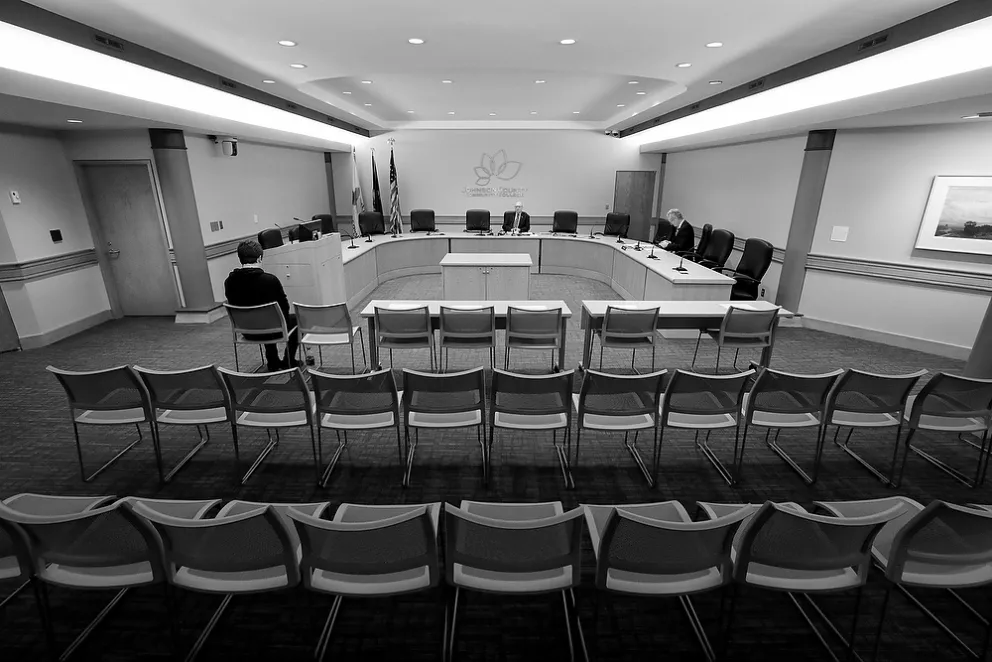
Susan McSpadden is marketing photographer at Johnson County Community College (JCCC) in Overland Park, Kansas. She has produced a weekly photo story since JCCC closed to all but essential personnel on March 14. See Week 1, Week 2 and Week 3 stories. In the photo above, the JCCC board of trustees altered their regular meeting to a live stream for safety, with only the chairman, college president and technicians physically present in the board room and following C.D.C. social distancing guidelines.
Like many UPAA photographers, my background is photojournalism, so I'm built for documenting. My institution, Johnson County Community College, just wrapped up the celebration of our 50th year, so looking back at historical events that helped shape our college and community was present in everyone's minds.
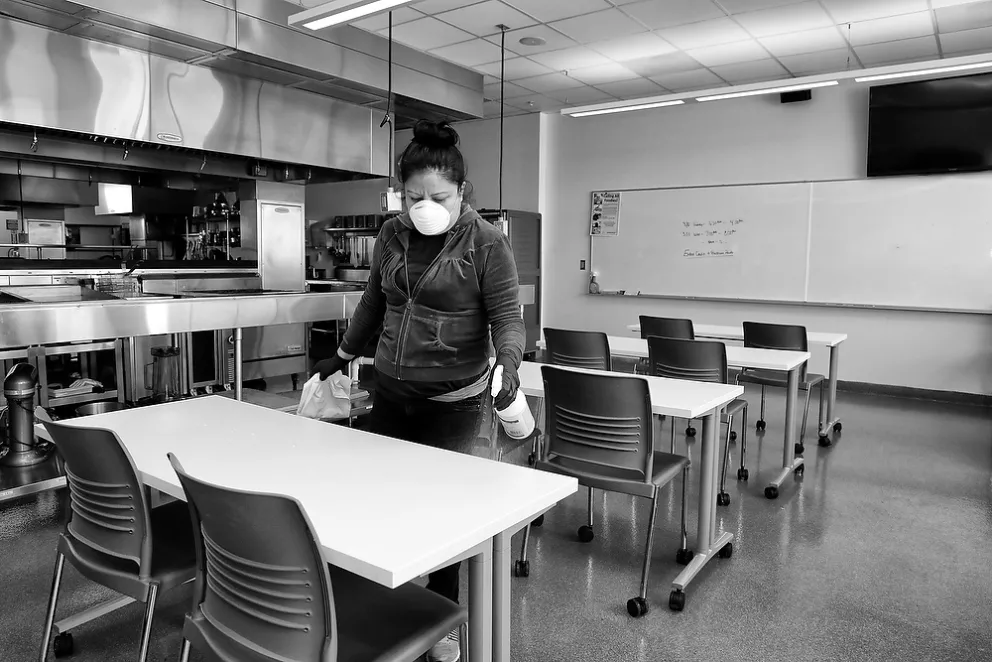
JCCC housekeeping staff sanitized campus after an employee tested positive for COVID-19.
That worked to my advantage when I approached our leadership about covering our response to the COVID19 pandemic. They recognize the importance of having visual representation of what this time was like. I am fortunate to have great support from all corners of campus. They know my work and more importantly, how I work, so they trust me to be safe and make smart decisions about what I'm covering.
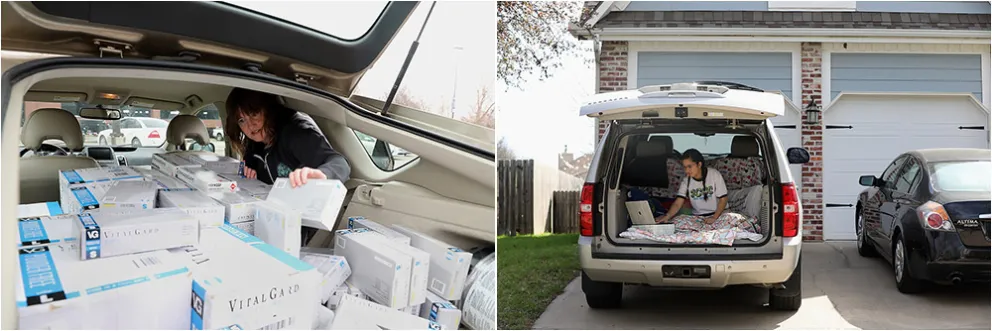
Left: Melanie Harvey, professor of science, along with colleagues from science and nursing programs pulled Nitrile gloves and other supplies from college labs to donate to area hospitals. Right: JCCC student Taylor Nguyen made her own space for studying in the back of her mom's SUV to get away from the chaos of a house full of siblings .
My goal is to choose a different theme or story each week to document. The longer this goes on, the harder it will be to do, but so far it's keeping me busy and I like the challenge of coming up with content. My institution is in the Kansas City metro area which includes areas of Kansas and Missouri. Both states are under "stay at home" orders. I've been impressed by faculty and staff's willingness to let me into their home life. Through my images as well as Zoom meetings, FaceTime, etc., we are all getting to know each other on a more personal level. Learning details of faculty, staff and students' lives outside of campus makes us more relatable to each other and it seems to be drawing us closer. It's nice to focus on the good during this very strange time and I'm grateful to get to capture it with the camera.
SANJAY SUCHAK - University of Virginia - Charlottesville, VA
"During this crisis, because of my colleagues across the university, I'm very proud to be a Wahoo."
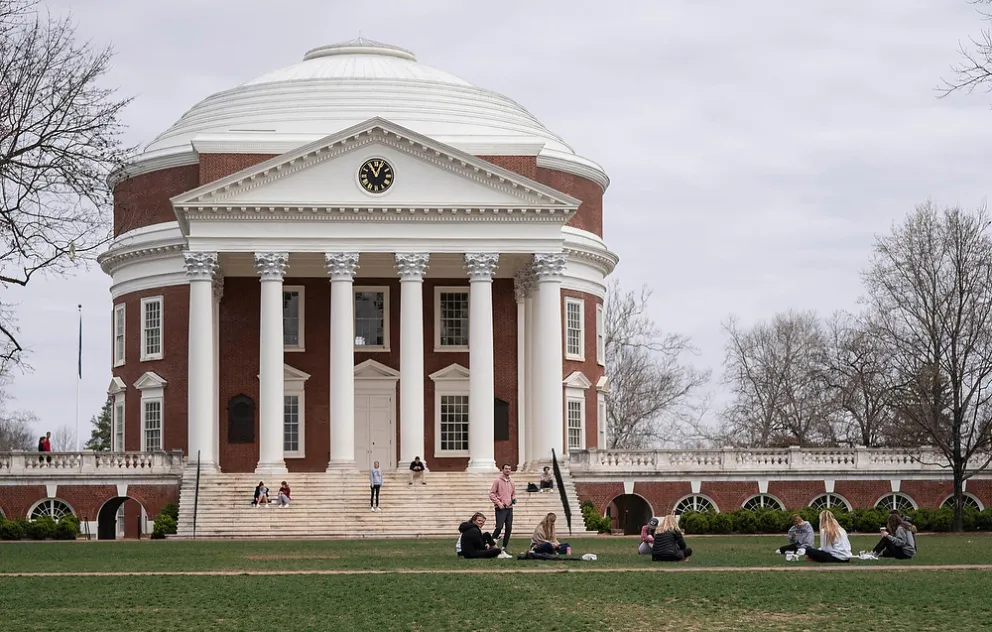
Sanjay Suchak is university photographer at the University of Virginia. He has published photo essays of the activities on the UVA campus (or "Grounds" as they're known) on Virginia's news site, UVAToday, see them here and here. Above: The famous Rotunda building on "the Grounds" at the University of Virginia on March 18, 2020, with students just beginning to observe the 6-foot social distancing guidelines.
The order to return home was issued over spring break, but St. Patrick's Day looked like any other one--students were defiant of the request to leave. Halfway through the revelry of the night, the Governor issued a new order and the university followed suit, demanding students leave. Eventually under duress or parental pressure they went home.
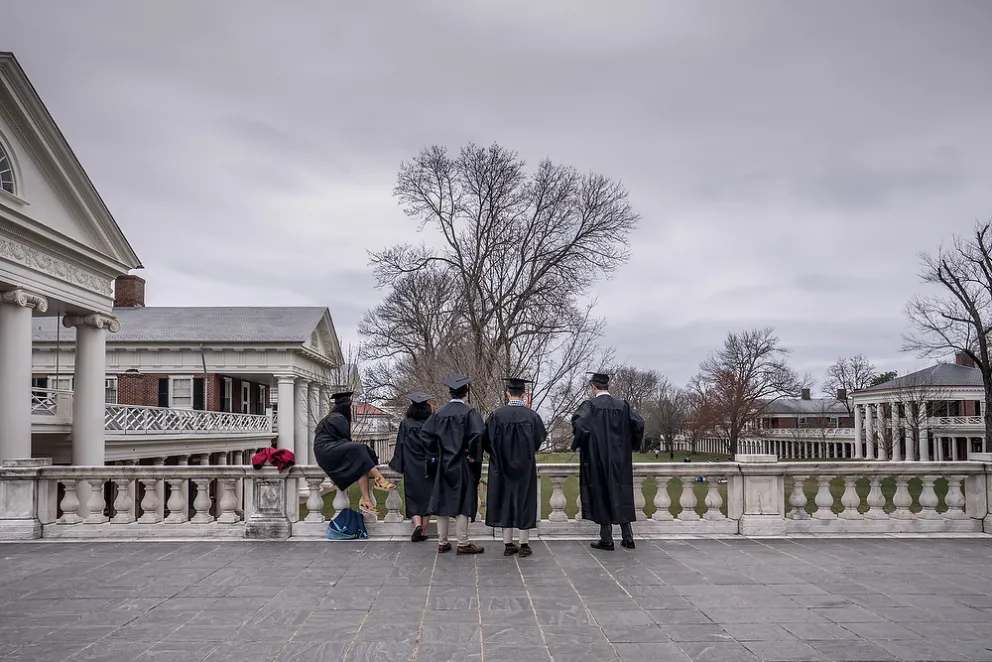
Students don caps and gowns for a last look at the Lawn before heading home.
Grounds fell silent. I was the last employee of our office on Grounds with any regularity. The essential employees and medical employees were left. This is where I started to see amazing things happen.
Two doctors in our health system took it upon themselves to create their own test for Covid-19, then submitted it to the CDC where it was approved. It was a complicated test, one that they could only run themselves. Soon a community member stepped up with a one million dollar grant so testing was expanded. We now can run tests for the other hospital in town and hospitals further afield. Another doctor and his lab assistants are starting to develop what they believe will be a vaccine.
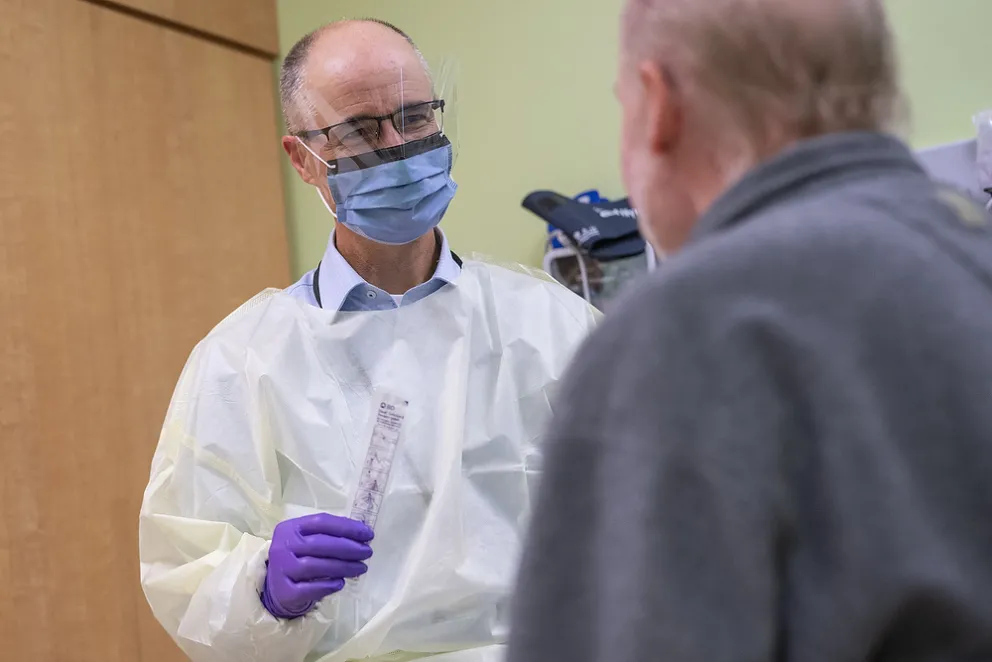
UVA medical staff administer their own COVID-19 test.
As the pandemic preparations started up, I was invited into the Health System to see and photograph what was going on there. In the coming days I photographed pre-sunrise meetings of health system leadership, war room type discussions. I went into the new Covid-19 ward, a converted floor of the new hospital wing which they rushed to completion and converted to help treat these patients. I was allowed into the Covid Clinic, with a strict warning to touch nothing. This is where patients who were in the testing pool and exhibited symptoms could be tested. I watched the staff be very deliberate with safety measures to ensure their safety and the safety of patients. I photographed the swab tests. Most poignant was the EVS professional, Mohammed, who cleans that clinic top to bottom every two hours, seven days a week, in a twelve hours a day shift. Everyone in this clinic volunteered for this job from elsewhere in the hospital. In a way this sums up how our university is operating. Everyone is on top of their game, working their hardest and everyone there is just as important as the person next to them.
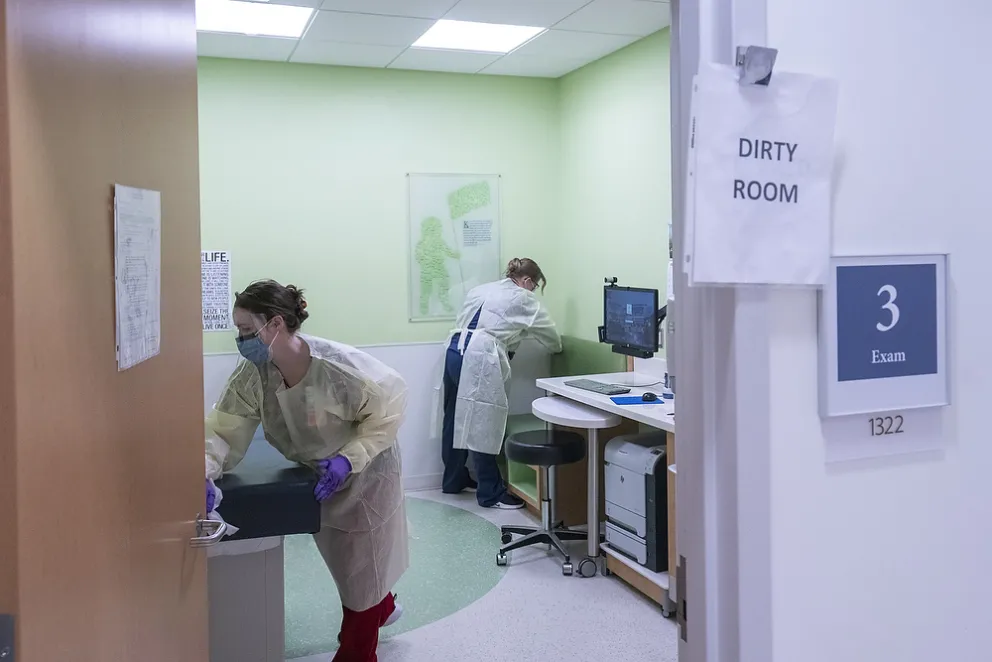
Nurses and environmental services professionals clean an exam room.
As more patients started coming in, I backed down from photographing the medical side for now. I can't justify using PPE to take photographs. I need to be safe while doing my job, but not at the expense of the safety down the road of those saving lives. I'd like to come back in later. We have some photographs in our special collections library from the Spanish Flu and I think these photographs in a century will be looked back as just as important. I spend about half my day now on Grounds, walking around, trying to find the people doing things to keep the place running. It's getting harder. Less and less is considered essential. I've never seen the grass so tall on the Lawn.
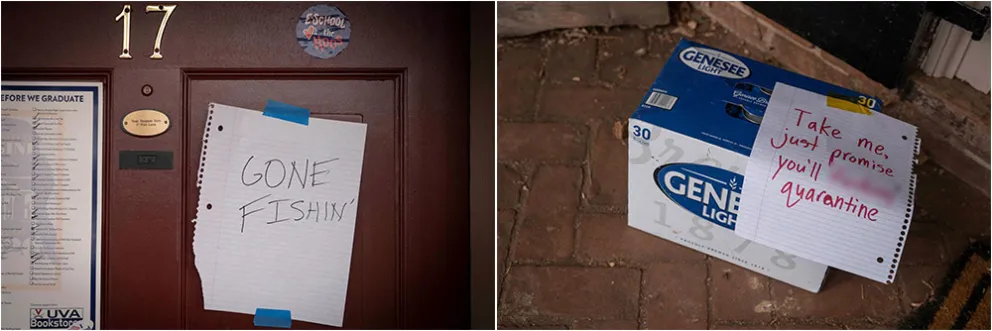
Lighthearted messages from departing students at UVA.
I worry that I haven't taken enough photographs, and there's something I'm missing. I'll keep doing this though until they physically restrain me from doing it, or I become sick. This doesn't mean I'm being careless, it's just that I don't sit still, I never was good at that. Thankfully I think the people I work with understand that about me. I'm lucky for that.
As those of you who work at large universities know, they sometimes feel like large lumbering entities with loose organization and often confusing hierarchy and bureaucracy. It took this strange time we are in to see that despite this feeling, there are hidden roots that tie areas, and when a situation like this arises, great things are possible. We all suffer from burnout in our jobs, but during this crisis, because of my colleagues across the university, I'm very proud to be a Wahoo.
ISABEL CHENOWETH - Southern Connecticut State University - New Haven, CT
"I thought it was important for everyone to see images that would make them feel that we are all in this together..."
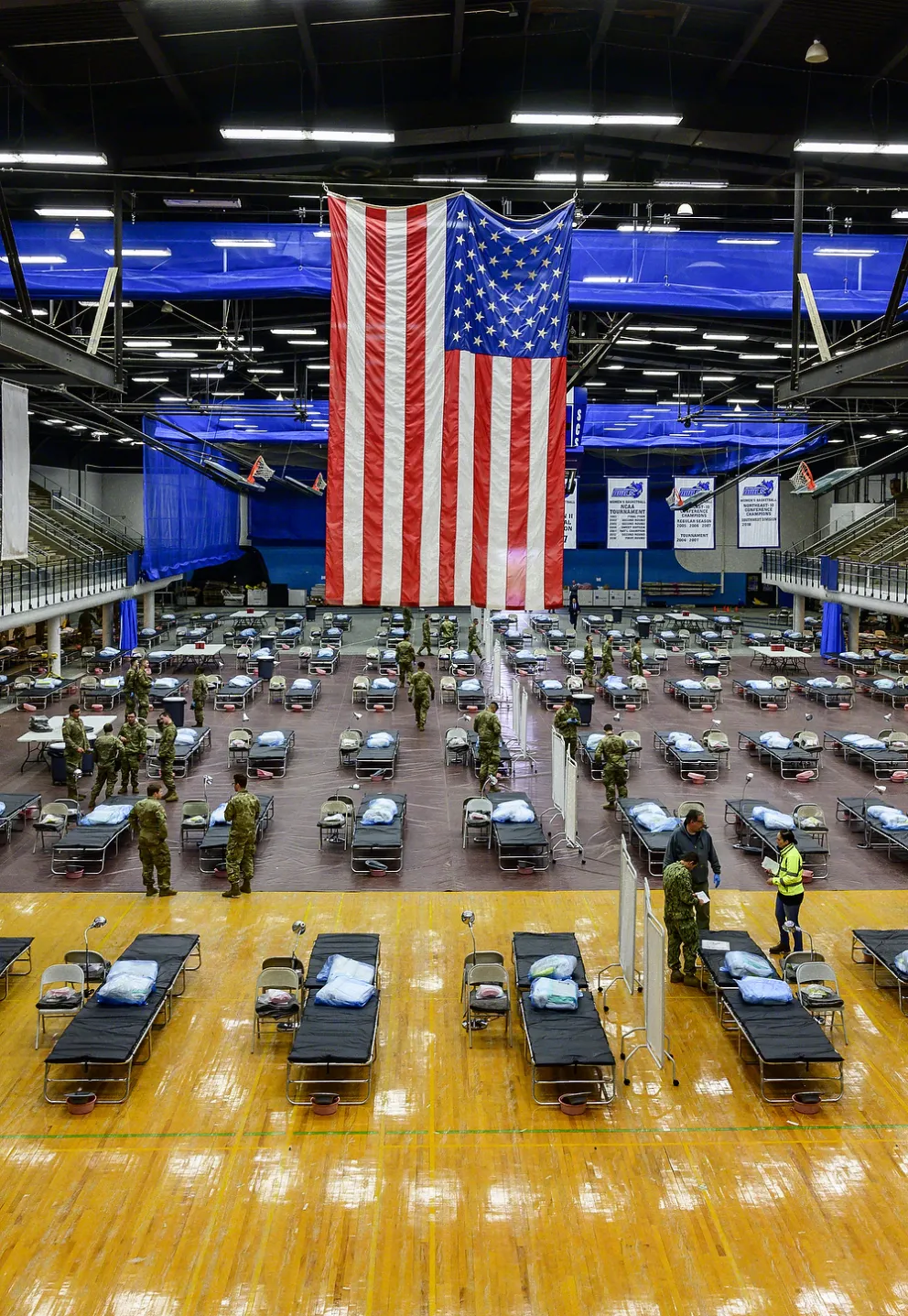
Isabel Chenoweth is university photographer at Southern Connecticut State University. Being in proximity to the New York City area, parts of the campus have been converted to emergency medical facilities. See her coverage on Instagram. Above, the SCSU gym is transformed into a field hospital.
Southern Connecticut State University has been closed since March 11, so opportunities to photograph on campus during the COVID-19 pandemic have been extremely limited.
However, when the Connecticut National Guard arrived on campus on March 31 to set up a 250-bed FEMA mobile hospital in the university field house, my director, Patrick Dilger (Director of Integrated Communications and Marketing), called me and gave me the option of returning to campus to photograph the event. The following day, I returned to campus to photograph Governor Ned Lamont’s tour of the medical facility and his accompanying press conference. On both occasions, Dilger emphasized that returning to campus was optional, and that I should photograph only to the extent that I was comfortable and nothing more. This gave me the freedom to assess the scene and make my own decisions about how to tell the story as it unfolded over those two days.
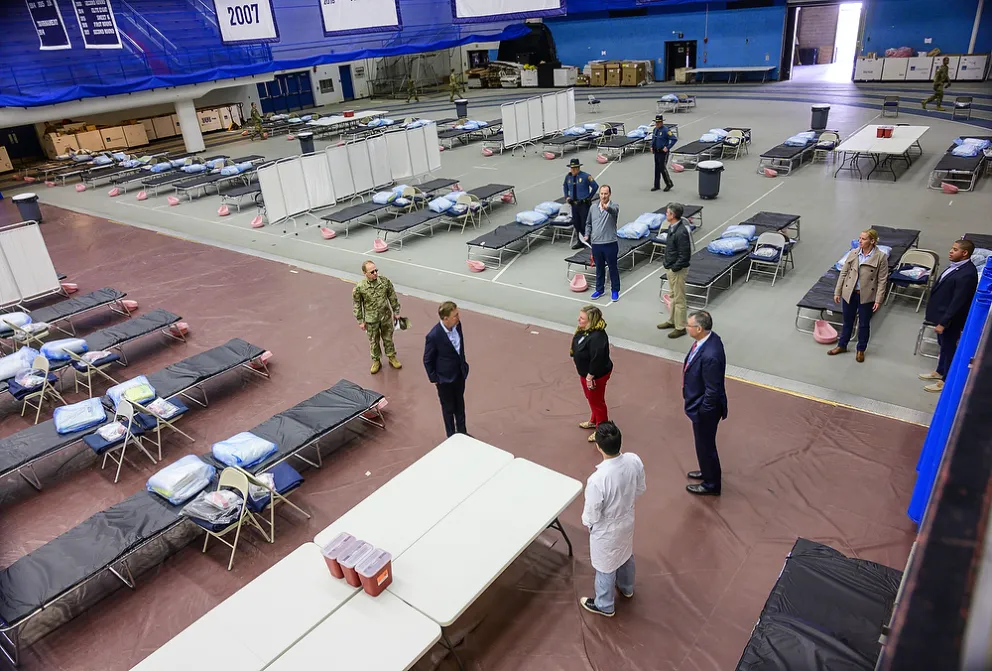
Connecticut Governor Ned Lamont tours the Southern Connecticut State University gymnasium after its conversion to an emergency medical facility.
My approach to photographing was to maintain social distance and also make images recognizable to the campus community. Since the common bond among a large diverse community of students, faculty, administration, staff, and alumni is the physical space, I thought it was important for everyone to see images that would make them feel that we are all in this together through the university, even while isolating at home. Making those decisions allowed me to focus on a wider perspective and physically separate from the journalists and other photographers covering the event, especially since the story of the university includes everyone there at that moment, including the media.
JAY FERCHAUD - University of Mississippi Medical Center - Jackson, MS
"I don’t mind saying I’m scared, but I'm always aware."
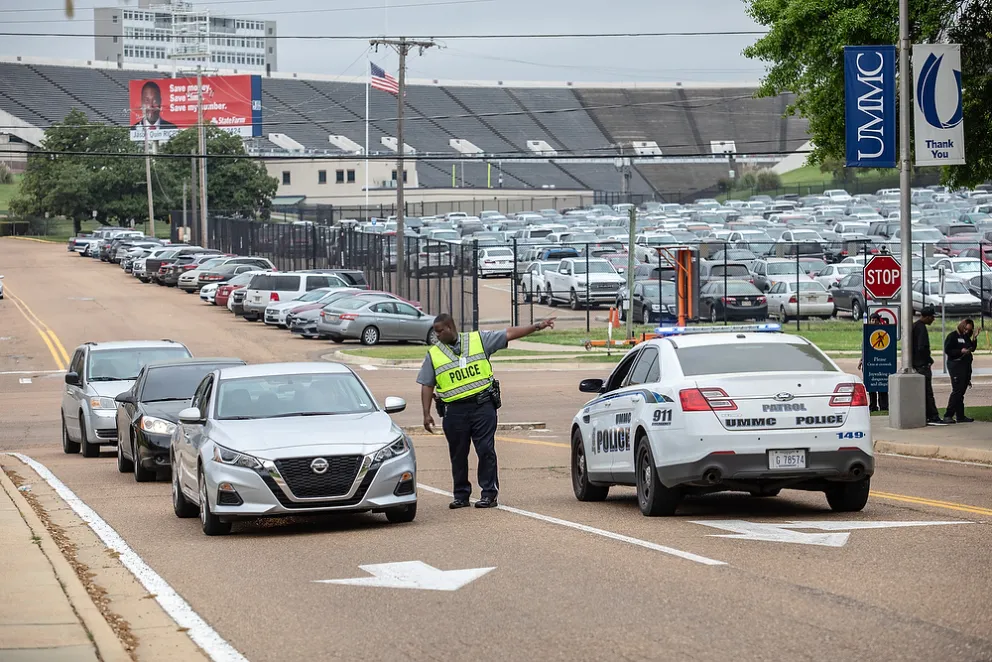
Jay Ferchaud is the photographer at the University of Mississippi Medical Center. See his coverage here. Above: A UMMC Police officer directs a motorist to a testing location on the UMMC campus.
I have shot many tough and emotional assignments over the years as a news photographer, but documenting the University of Mississippi Medical Center's response to the spread of the novel corona virus is the top if the list. I don’t mind saying I’m scared, but I'm always aware.
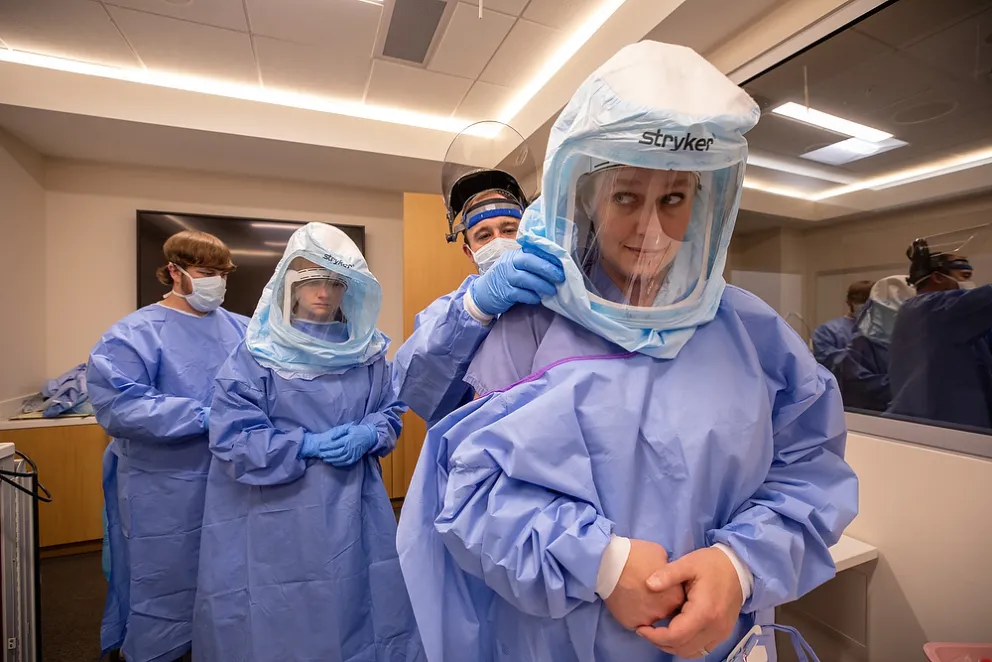
John Carter, left, MICU nurse, helps Jessie Harvey, second from left, assistant professor of medicine, pulmonary, don protective gear while J.D. Chisolm, second from right, MICU nurse, does the same for Kelly Jones, respiratory therapy supervisor, during a training session.
When taking photos during the COVID-19 pandemic, I am constantly aware of my surroundings and never touch anything that would allow the virus to spread. My hands, desk and camera equipment are disinfected with hand sanitizer, 91% alcohol and Clorox wipes repeatedly through the day. Hand sanitizer is always in my top pocket.
My supervisor has been busy during this crisis but always takes time to thank everyone for their hard work. He said we were doing a fantastic job and the university was lucky to have such a great team of communications and marketing professionals.
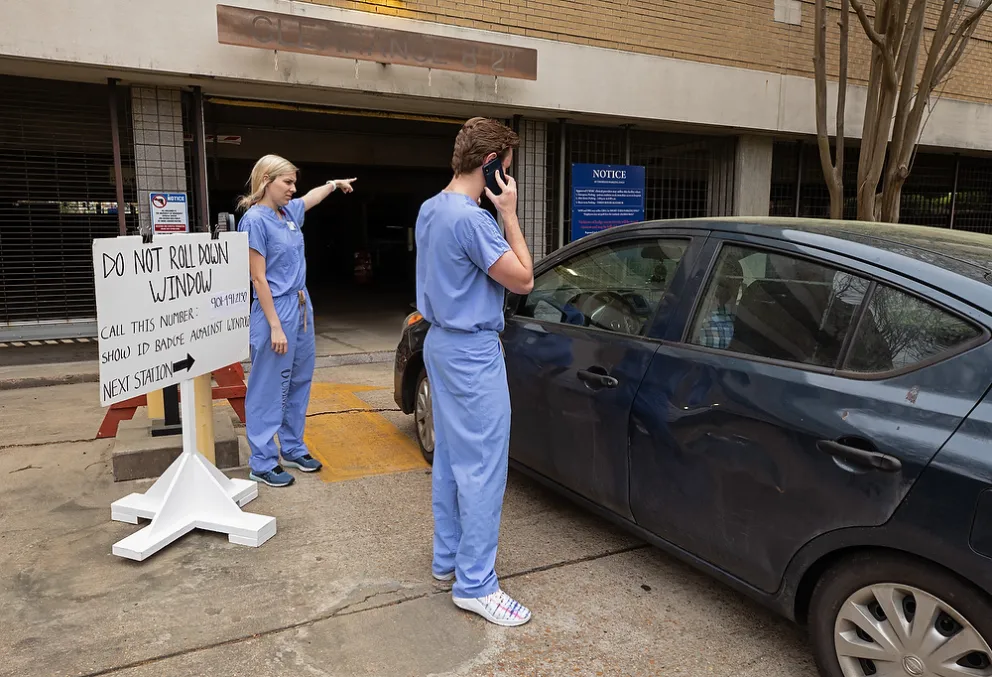
Alexandra Bensel and Bobby May Jr., third year medical students, direct traffic to the COVID screenings for employees in a parking garage.
At University of Mississippi Medical Center, everyone -- doctors, nurses, staff members and students -- is pulling together as a team, even if that means taking on tasks that you normally would not do in order to save lives.
PHYLLIS GRABER JENSEN - Bates College - Lewiston, ME
"Unequivocal support from my boss to forge ahead."
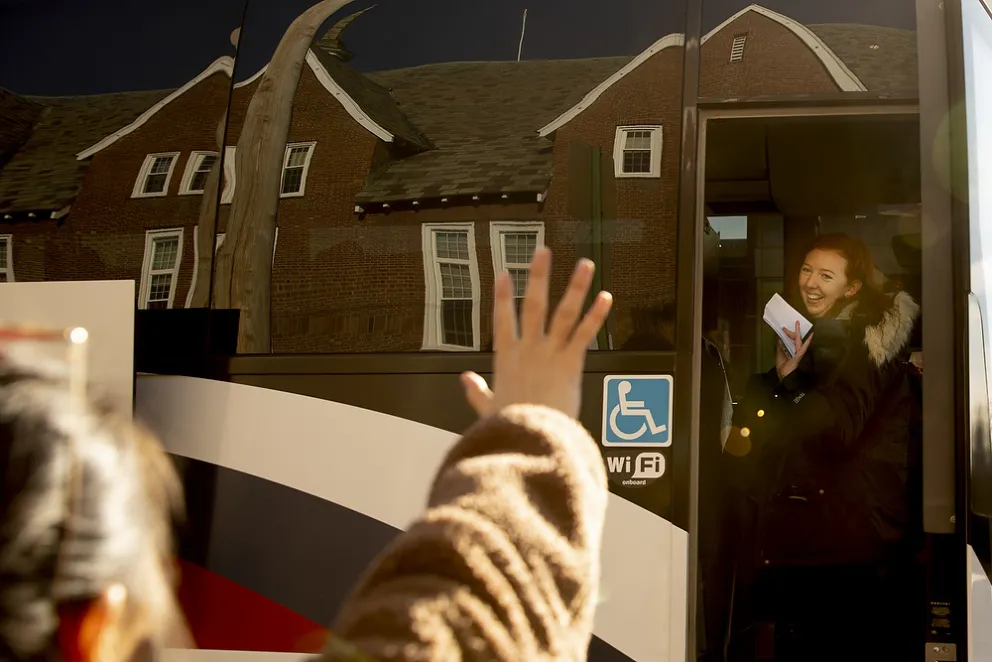
Phyllis Graber Jensen is director of photography and video for Bates Communications at Bates College. See a photo essay story here. Above: Taillte Cooney-Newton '23 of Galway, Ireland, receives a farewell wave from a friend as she boards a bus to begin her journey home.
In my years at Bates College, I’ve covered tragedies and triumphs. The challenge of covering very sad events, such as 9/11 or a campus death, is trying to convey, in still images, how these events deliver a seismic jolt to our tight-knit community — and how the community remains solid and strong and supportive.
On the morning of Friday, March 13, the Bates College president, Clayton Spencer, announced that the college would suspend in-person classes at day’s end. Students would need to depart campus within just five days. Remote learning would start in 10 days.
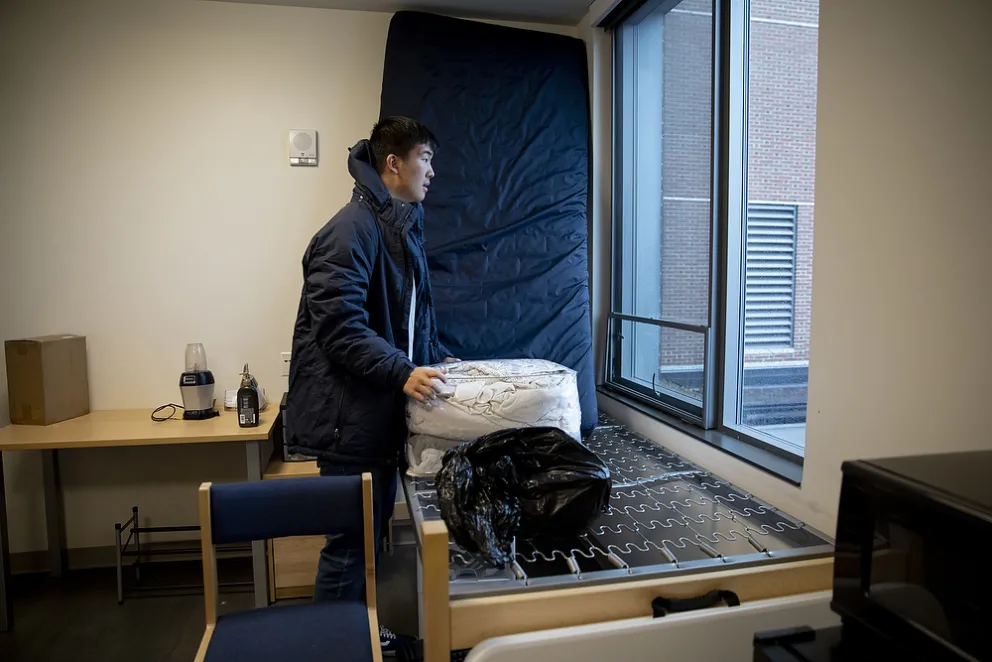
David Chen ’23 of Rockaway, N.J., packed up his room, said goodbye to friends and his College Street view, and headed to the lobby to await the arrival of his father, who was driving up from New Jersey. He was “just starting to find my place at Bates.”
The announcement was shocking but not unexpected. Only I hadn’t mentally prepared for it. So I reacted by running over to the office of a professor I’ve been following for a long-form word and picture story focusing on her 34th and final year of teaching.
She didn’t have a class that morning but students were coming to her office for scheduled meetings, for reassurances, and to say goodbye. I started shooting. One of her departmental colleagues was about to teach a final class and told me I could photograph. I shot that class.
Bates is a small place, easy to be familiar with many students, faculty, and staff. I felt I was in a pinball machine (remember them?): Each situation gave me additional intelligence about another situation. I kept shooting, doing brief interviews along the way, too. “I was just starting to find my place at Bates,” a first-year told me as he walked out of his empty dorm room.
I didn’t yet have specific directions or assignments, just my usual internal, professional guidance — “Bates Communications needs to document this” — plus the unequivocal support from my boss to forge ahead.
And that’s what I did, from Friday afternoon to final departures on Tuesday, seeing how the Bates community rallied to help students make this huge move, providing any manner of support, whether boxes, counseling services, visa help, or no-questions-asked financial assistance. I kept shooting.
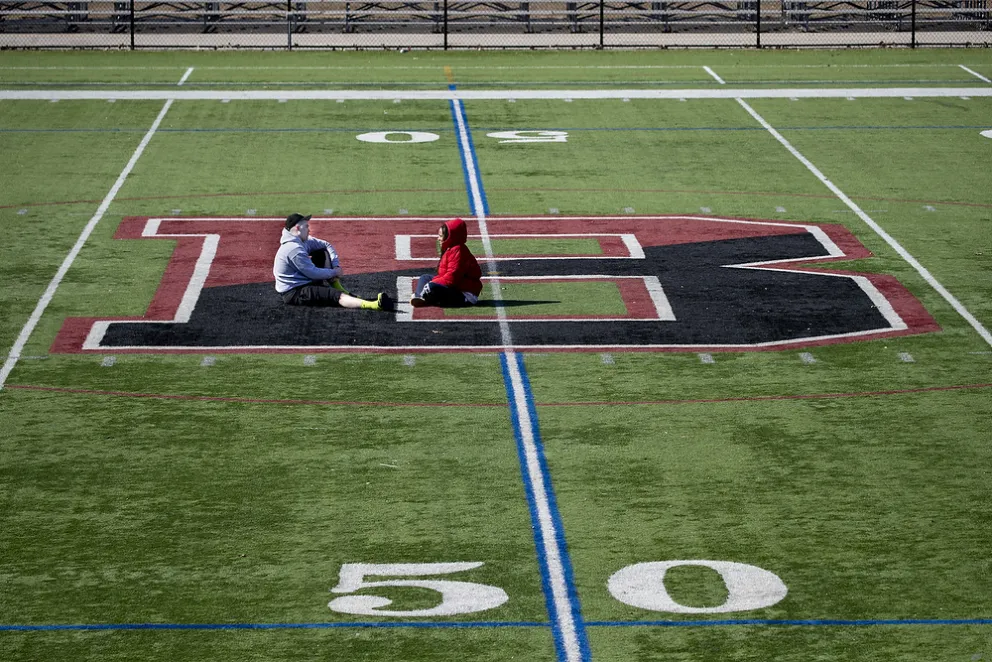
“He’s going abroad for all of next year, so this is our last time together on campus,” said Christine Bourdeau ’21, a biology major from Milton, Mass., seated with Alex Gailey ’22, an English major from Berkeley, Calif., on a warm patch of turf near midfield on Garcelon Field.
Creating and delivering a coherent visual story came from collaboration within our Bates Communications Office. As we do for event-driven stories, we used the Exposure platform. I wrote draft text and laid out the story.
From there, our editorial director and magazine editor, H. Jay Burns worked his magic and shaped it into its final form. We have a long history of working together on projects like this, so that collaboration with him really helped.
JAY DROWNS and GABE MAYBERRY - Utah Valley University - Orem, UT
"During this event, it is crucial to capture the visual history..."
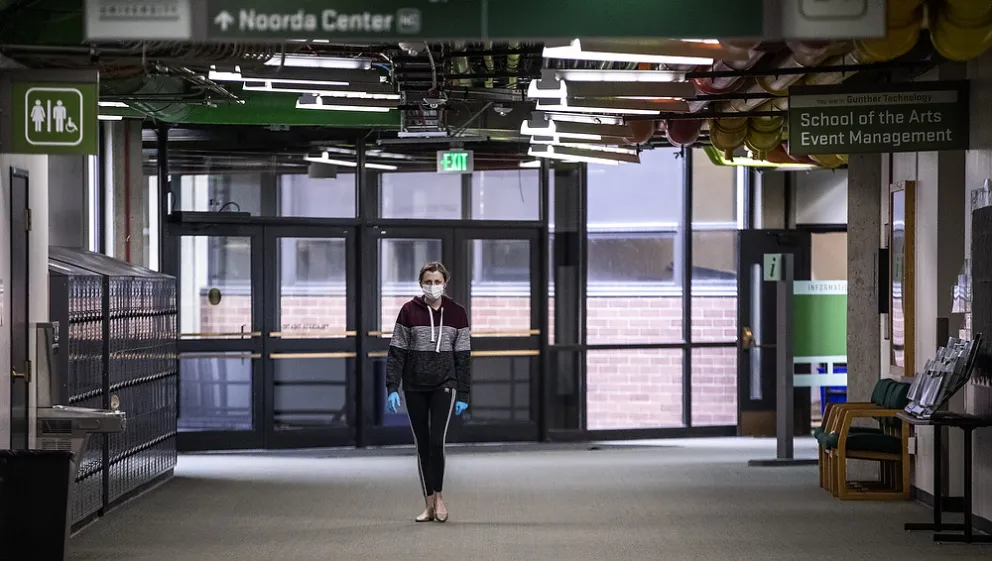
Jay Drowns is assistant director of photography at Utah Valley University (UVU). See coverage from Jay and his colleague Gabe Mayberry here. Above: The UVU campus in Orem, Utah Tuesday, March 24, 2020 after classes were shifted to online. (Jay Drowns/UVU Marketing)
As a team, we make a concerted effort in proactive visual storytelling in the best of times. During this event, it is crucial to capture the visual history to keep the current university community informed as well as allowing future students, faculty and staff to look back at how we handled the situation.
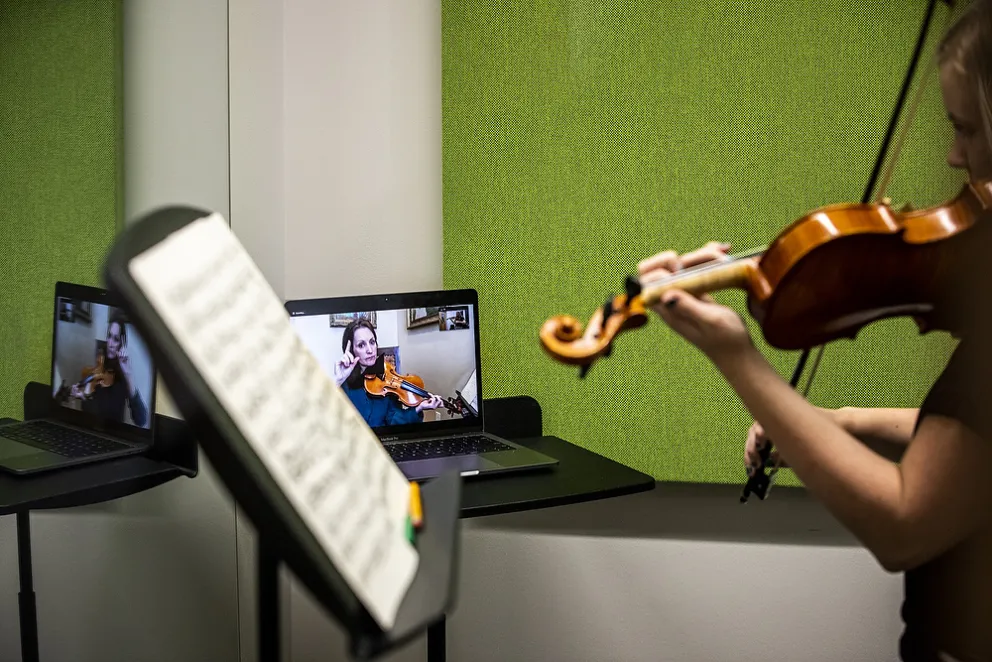
A music class via Zoom. (Jay Drowns/UVU Marketing)
While I was photographing I did my best to keep my distance from others. I also had a ziplock bag in my pocket with Clorox wipes and a small hand sanitizer bottle that I used a few times. Several times I had to remind people that we should keep a safe distance and not shake hands. There were only a few times when I was in close proximity to others while photographing for the photo essay.
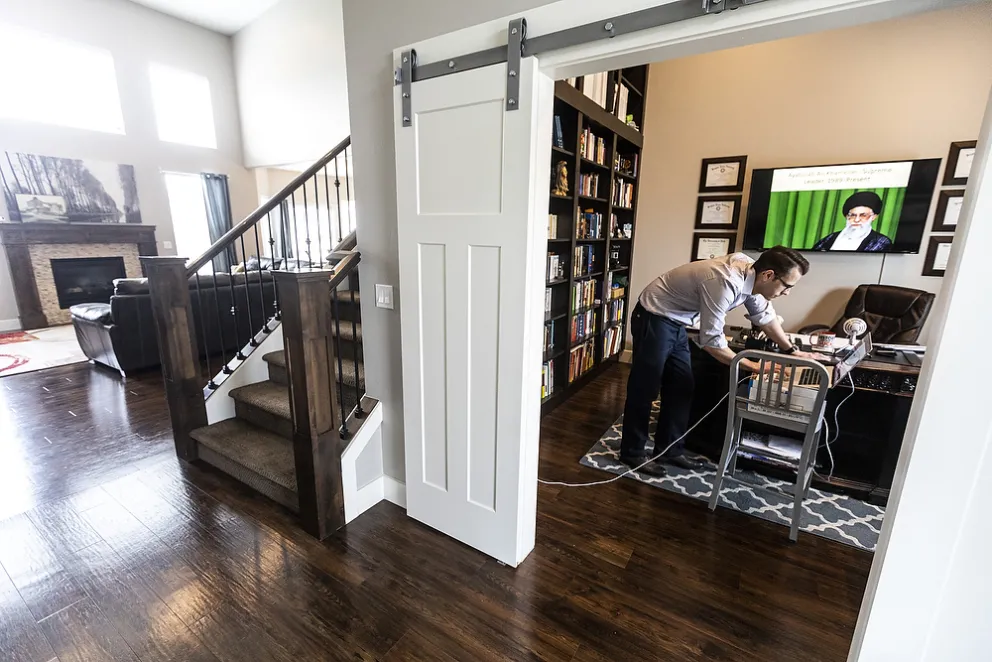
Gabe Mayberry is photography manager at Utah Valley University. Above: Utah Valley University professors Dr. Gregory Jackson and Dr. Sue Jackson are photographed in their home conducting courses and departmental meetings online as the COVID-19 virus has ended in-person activities at UVU on March 26, 2020. (Gabriel Mayberry/ UVU Marketing)
During our first remote department meeting we asked for approval to document Utah Valley University's response to the Covid-19 pandemic. As a photo team we had already begun documenting the transition to online learning the previous week for news purposes. Our goal was to be proactive instead of reactive and gain access to different levels of the university. We wanted to document professors teaching from home, students in their new study habits in their apartments, and university administration as they were deciding the direction of the response. Once we had a good sampling of images we would release an exposure gallery to our campus community.
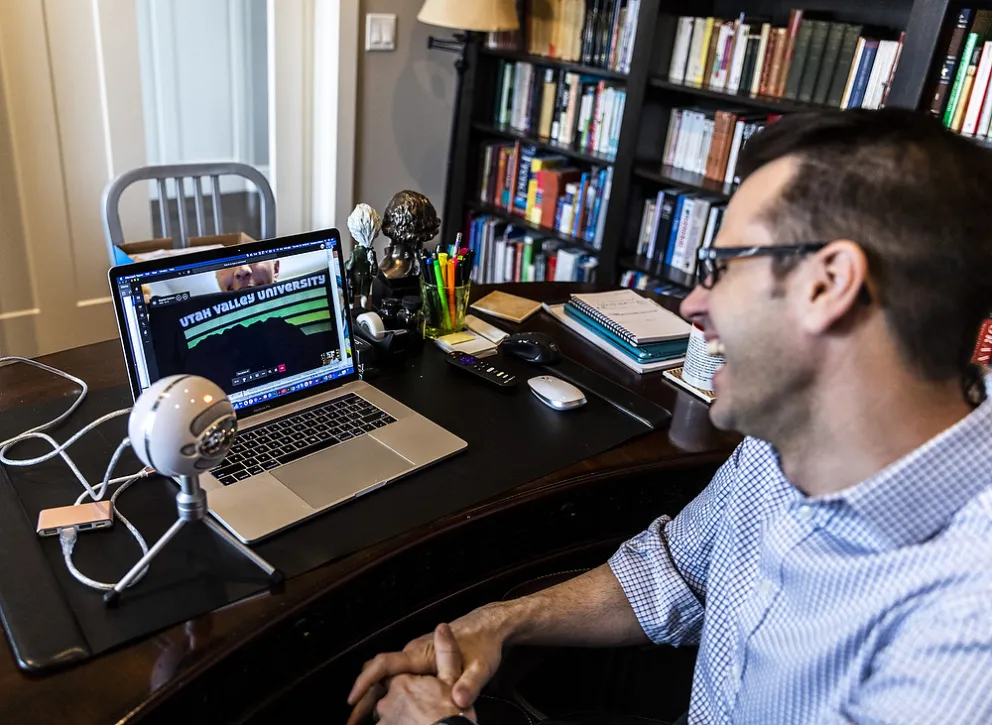
Dr. Gregory Jackson enjoys a lighter moment of remote learning with a student.
We were surprised in the beginning at the difficulty we faced in our proactive efforts. Our coverage became easier to pitch after we communicated the need for historical documentation and the need for proactive, positive messaging. Once our directors began to see the kinds of images we were making, it wasn't as much of a problem in asking for further coverage opportunities. As a photo team we've realized that through this hardship we have a stronger and more refined focus of visually representing the UVU story.